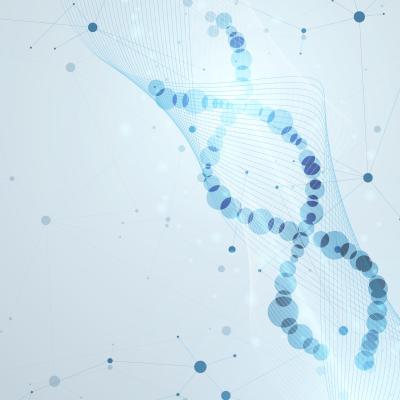Genetic engineering allows insertion and propagation of a foreign genetic element in a heterologous system in a variety of applications such as the creation of genetically modified organisms (GMOs) in the field of agriculture or production of therapeutic proteins and antibodies in the field of healthcare. However, such genetic insertions often lack the required stability to be maintained for…
Keywords
- Additive Manufacturing (54)
- Instrumentation (40)
- Sensors (14)
- Diagnostics (12)
- 3D Printing (8)
- Therapeutics (7)
- Brain Computer Interface (BCI) (5)
- Ground Penetrating Radar (4)
- Synthesis and Processing (4)
- Defense Technologies (3)
- Manufacturing Automation (3)
- Microfabrication (3)
- High Explosives (2)
- Manufacturing Improvements (2)
- National Security Forensics (2)
- Rare Earth Elements (REEs) (2)
- Vaccines (2)
- Volumetric Additive Manufacturing (2)
- Manufacturing Simulation (1)
- Precision Engineering (1)
Technology Portfolios

LLNL inventors have developed a new multi-wavelength laser scanning system for use in two-photon printing. By integrating multiple laser beams with various choices of wavelengths, the invention provides a new pathway to fabricating a multi-material 3D structure in a single vat process while achieving increased printing resolution beyond diffraction limit. The technology uses multiple…
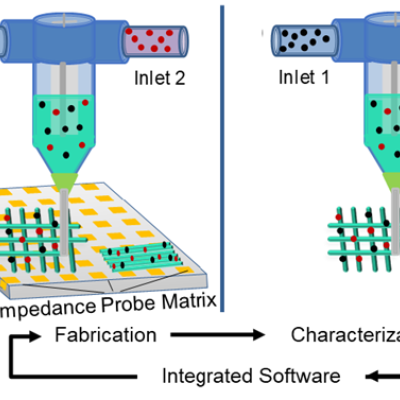
The platform has three major components:
(1) active-mixing direct-ink-write
(2) in situ characterization substrates or probes
(3) active learning experimental planning system.
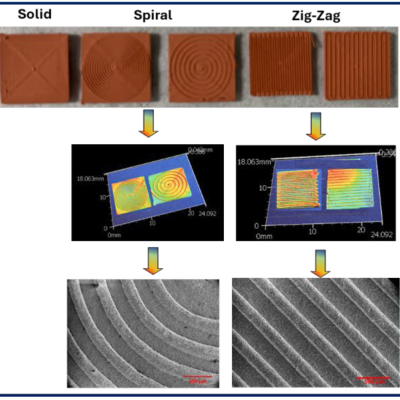
LLNL researchers has developed a composite copper current collector formulation readily used in DIW 3D printing to guide lithium-ion plating/dissolution during charging and discharging cycles.

LLNL researchers have developed an approach to form silicon carbide (and diamond) nanoneedles using plasma etching that create micro pillars followed by chemical etching of the pillars in forming gas containing hydrogen and nitrogen. Combining these two etching processes allow for fabrication of micro- and nanoneedles that are thinner and sharper than conventionally fabricated needles.
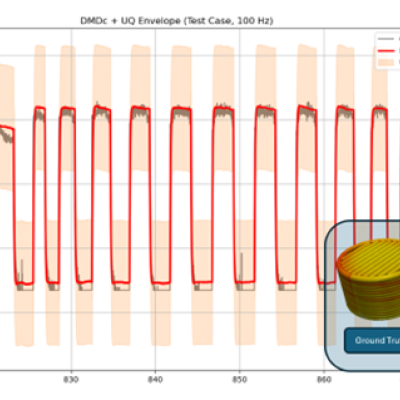
This invention addresses the critical challenge of achieving consistent results in additive manufacturing by introducing a novel system that integrates a comprehensive array of sensors into the manufacturing process. These sensors gather multiple data streams, which are then used to construct a detailed model of the system. The key innovation is its ability to handle MIMO while maintaining…
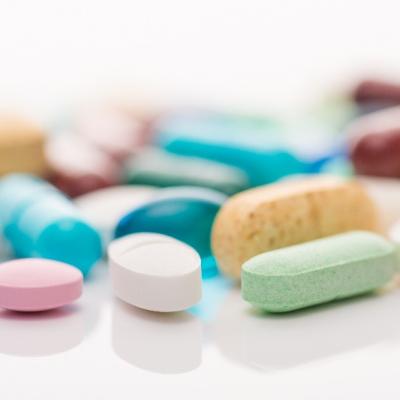
After screening at least 50 different cyclodextrins, LLNL researchers found that the drug Subetadex shows enhanced affinities for fentanyl and its analogues. Subetadex is a smaller version of sugammadex and with a smaller central cavity, allows it to bind extremely well to fentanyl by comparison. A pharmacokinetic study showed a rapid clearance of this promising candidate from…
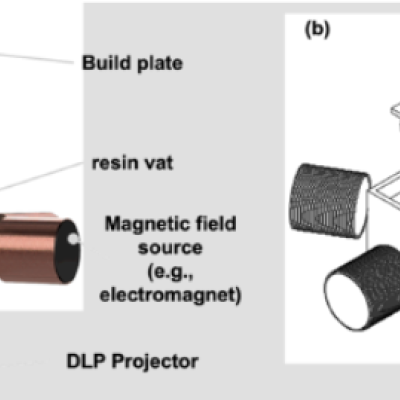
This LLNL invention is capable of generating, on-the-fly, tunable magnetic field strengths with voxel-by-voxel alignment. The approach is to use a custom designed Halbach array consisting of permanent magnets or electromagnets to provide a uniform magnetic field in any direction. This Halbach array will then be coupled with a stereolithography (SLA) printer so that locally aligned…
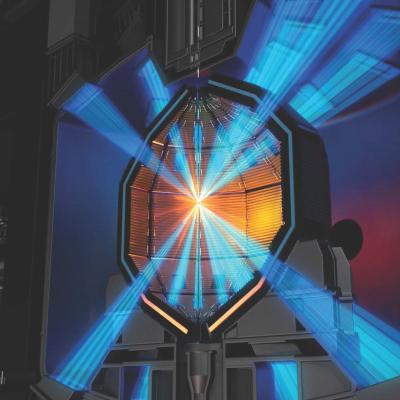
LLNL researchers have developed additive manufactured fuel targets for IFE. They have been successful in using TPL to fabricate low density (down to 60 mg/cm3) and low atomic number (CHO) polymeric foams for potential targets, and some have been tested at the OMEGA Laser Facility. With TPL, LLNL researchers have also been able to fabricate a full fuel capsule with diameter of ~ 5mm or…
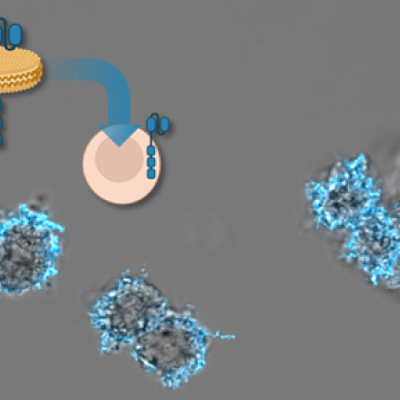
Rather than using genes carried by viruses, LLNL researchers have developed an alternative approach of delivering CAR to T-cells in form of proteins that are carried on the surface of nanolipoprotein (NLP) particles. NLPs are naturally occurring molecules that serve as structural mimics of cell membranes. They can self-assemble and provide a structure or platform for connecting other…
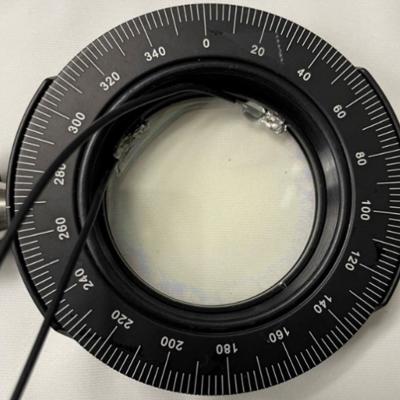
The approach is to use appropriately doped semi-insulating gallium nitride to provide a high damage tolerant photoconductor with high responsivity to various pump wavelength light. Mn, C, or Fe are used as dopants to provide a source of electrons or holes that can be excited. This is combined with the use of dichroic antireflection coating at the GaN/polyimide/liquid crystal…
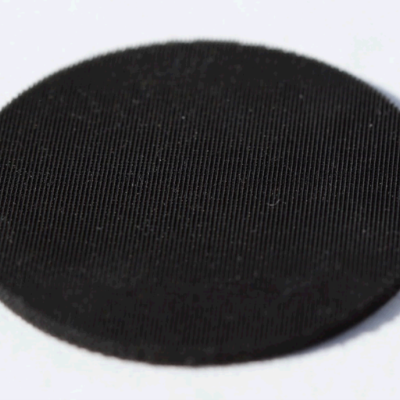
LLNL researchers have developed a silicone based conductive, elastomeric 3D DIW printed structure with a lower wt.% conductive, composite filler to allow for the creation of 3D printed lattice structures with tunable conductivity. The conductivity of the printed structure can be varied using composition of the starting DIW ink formulation as well as the 3D printed spacing and…
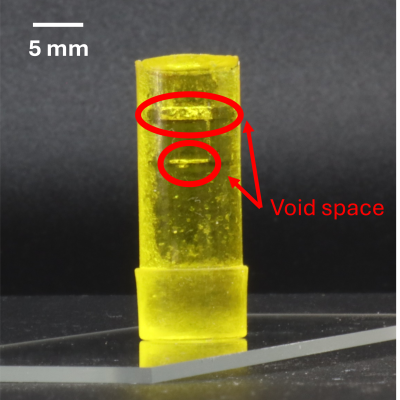
This LLNL invention is comprised of (1) a volumetric subtractive manufacturing system which can tomographically manufacture 3D structures with negative features (materials in negative space is degraded with light exposure), and (2) a hybrid volumetric additive/subtractive manufacturing system in which a gelled/solid structure is printed by resin material polymerization using one light, and…
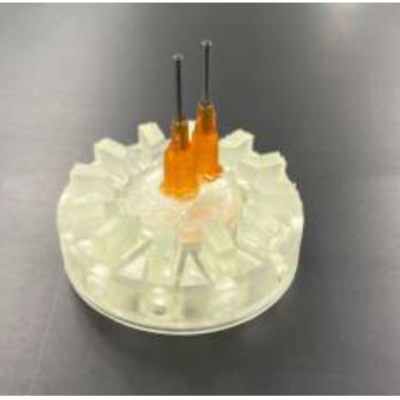
This invention focuses on the design of a fully interchangeable hub-droplet device apparatus for multiple droplet generation in parallel. The novel central hub combined with interchangeable chip configuration allows the use of different planar droplet generation devices that can be replaced and exchanged as needed. By separating the central housing hub which distributes incoming liquids into…
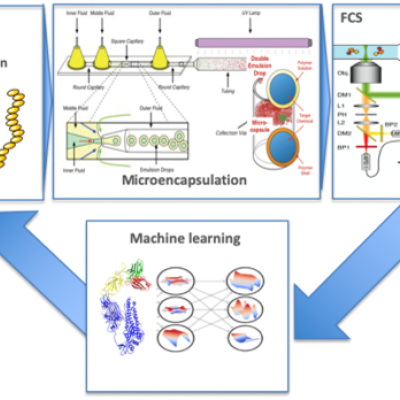
LLNL inventors have developed a method and device for the high throughput screening of various chemical and biological entities using a novel combination of cell-free protein synthesis (in vitro transcription-translation), microencapsulation and optical interrogation (Figure below). This includes automated sample handling, microemulsions, microfluidics manipulation, machine vision,…
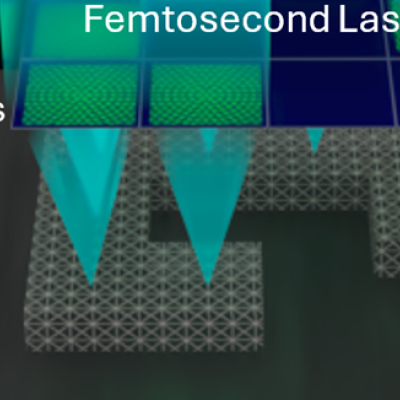
LLNL researchers have developed a parallelized TPP system that combines metalens array and spatial light modulator (SLM) to manipulate the directed laser light, which enables high-volume fabrication of nano-architected structures at wafer-scale. Instead of using a single microscope objective, LLNL’s approach uses an array of metalens that the laser passes through with each metalens being…
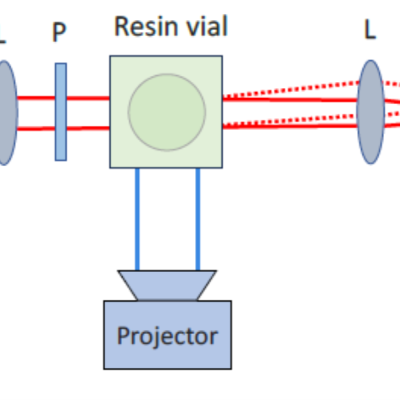
The approach is to use quantitative phase imaging (QPI) using a common-path phase-shifting interferometry technique. A sequence of four phase shifts with an increment of π/2 between unscattered reference beam and scattered sample beam are imparted by a spatial light modulator. A quantitative phase image is retrieved from four raw intensity images. QPI is a highly sensitive…
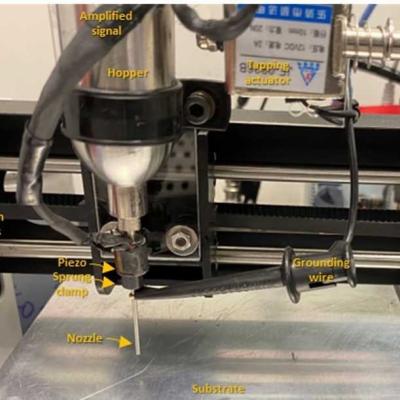
LLNL researchers have developed a piezo-driven jetting powder AM method that provides better control of the packing of printed powder. Powder is fed via a stainless-steel hopper to a nozzle; at the narrowest necking point the powder jams, and flow ceases. A vibrating piezoelectric element (with through-thickness vibration mode) is driven by a 150V AC signal to disturb the jammed powder,…
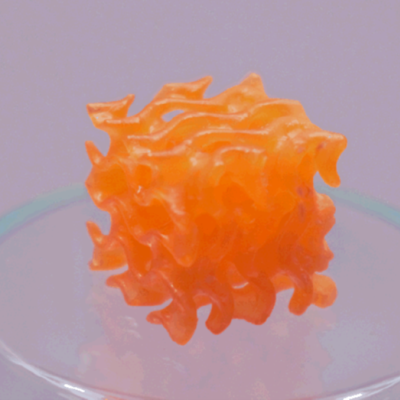
LLNL researchers have developed a method which utilizes functional alcohols to depolymerize polyurethane crosslinked networks. The functional alcohols show 5X increase in the depolymerization efficiency compared with current state of art (e.g. methanol, ethylene glycol). The crosslinked polyurethane networks completely depolymerized into a liquid oligomer within 48 hours at ambient…
LLNL researchers have developed a novel photocurable silicone useful for producing three-dimensional objects via additive manufacturing. The resin formulations consist of a mult-component siloxane polymers with different functionalities, a platinum catalyst, a photoinitiator, and other organic peroxides. The LLNL invention involves controlling the spatial and temporal aspects of the…
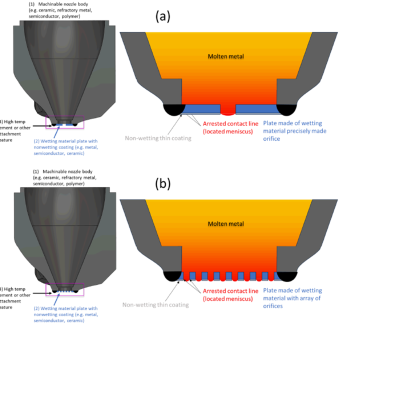
Nozzle design and manufacturing greatly affects the performance of LMJ printers. This LLNL invention describes a novel multi-part nozzle design that improves their performance.
The approach that LLNL researchers developed involve:
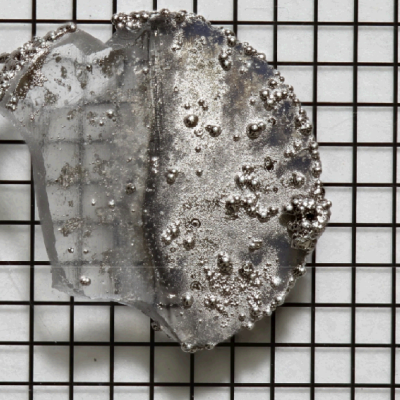
LLNL researchers have continued to develop their pioneering DIW 3D-printed glass optics technology that allows for the 3D printing of single- and multi-material optical glass compositions in complex shapes. This LLNL invention further proposes incorporating dopants (including, but not limited to TiO2 and Pd) into slurries and inks for 3D printing of glass components that can then be directly…
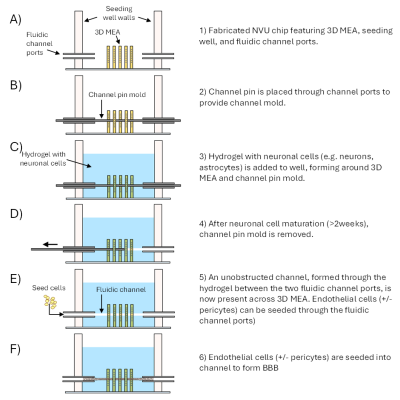
LLNL inventors have developed a proprietary concept and a prototype NVU device that provides an effective in vitro model of the BBB to discover, develop and screen drug candidates for their ability to cross the BBB. The device could also be useful in studying neurological disorders with defects in BBB to understand the mechanism underlying the pathology of the disease that might…
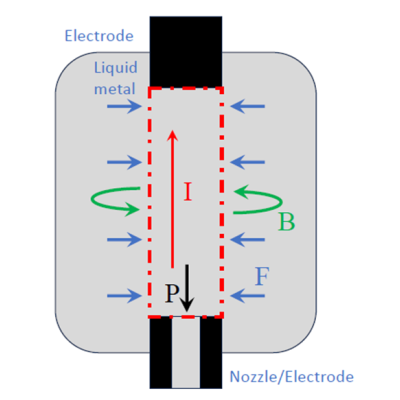
LLNL researchers developed an approach that uses a Z-pinch magnetohydrodynamic (“ZMHD”) pulse as the pressure pulse to emit the liquid metal droplets. ZMHD produces a large current pulse to traverse a column of conducting liquid metal. This pulse induces a magnetic field through Ampere’s law, and that field then interacts with the current pulse via the Lorentz force to generate a…
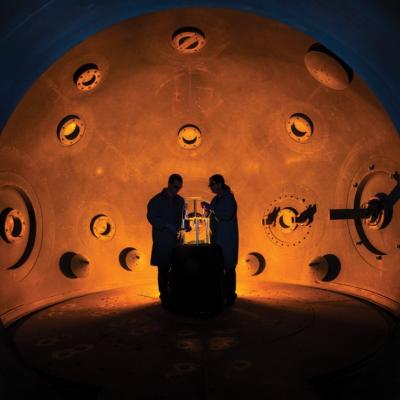
LLNL has developed a method that adds a polyamine based crosslinker and an acid receptor, based on MgO nanoparticles into a polymer bonded PBX, where the polymer binder is a fluoropolymer containing vinylidene difluoride functionality. Crosslinking kinetics can then be controlled by selecting an appropriate amine structure, pressing temperature and optionally the addition of a chemical…

This invention, hereby called liquid metal binder jetting (LMBJ), uses a molten metal as the “binder” that is deposited on ceramic powder, resulting in a multi-material fabrication process that includes both the ceramic and metallic phase in the same process. The simple process involves four steps:

LLNL researchers have designed and developed a novel high-density, high-channel count 3D connector that enables hundreds or thousands of nonpermanent connections within a compact footprint. The connector addresses limitations of currently used conventional approaches that were described previously, which have an artificial ceiling on the number of recording sites of modern devices of no more…

As an important step toward overcoming the technical and environmental limitations of current REE processing methods, the LLNL team has patented and demonstrated a biobased, all-aqueous REE extraction and separation scheme using the REE-selective lanmodulin protein. Lanmodulin can be fixed onto porous support materials using thiol-maleimide chemistry, which can enable tandem REE purification…
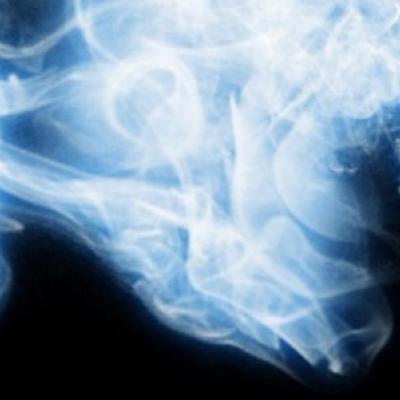
LLNL researchers uses Additive Manufacturing (AM) to create reinforcing scaffolds that can be integrated with High Explosives (HE) or solid rocket fuel with minimal volume fraction. Its main benefit is to create stability in harsh field conditions. Its secondary benefit is providing another method to finely tune blast performance or fuel burn. Creating complex shapes with structural…

LLNL researchers have designed and produced, both conductive and non-conductive porous electrode components manufactured for improved metal deposition, discharging, and fluid dynamics in hybrid flow batteries. This is achieved through Direct Ink Writing (DIW) additive manufacturing. The engineered 3D electrodes enable uniform current distribution and even metal deposition during…
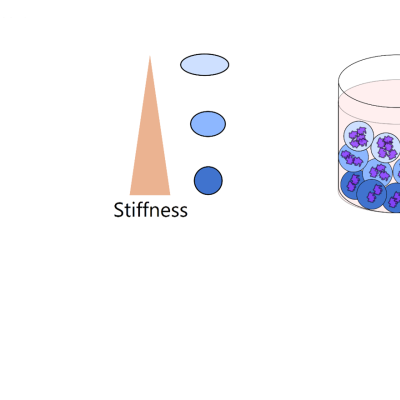
LLNL researchers have enhanced and expanded the IDEA technology, which fabricates micron-scale droplets that are then crosslinked in-air (within milliseconds) using a UV light source before collection. An aerodynamically shearing air jet or acoustic vibration force causes rapid droplet formation.
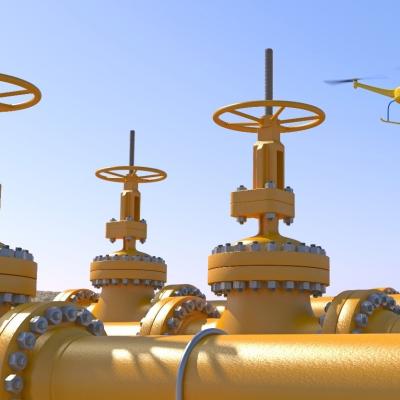
LLNL researchers have developed a TDLAS-based, standalone, real-time gas analyzer in a small form-factor for continuous or single-point monitoring. The system can analyze multiple gases with ultra-high sensitivity (ppm detection levels) in harsh conditions when utilizing wavelength-modulation spectroscopy (WMS).
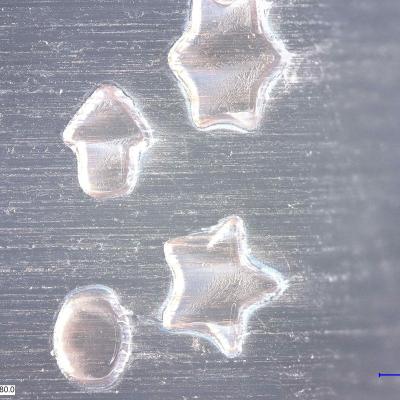
LLNL’s invention is a photopolymerizable polymer resin that consists of one or more nitrile-functional based polymers. The resin is formulated for SLA based 3D printing allowing for the production of nitrile-containing polymer components that can then be thermally processed into a conductive, highly graphitic materials. The novelty of the invention lies in (1) the photo-curable nitrile-…
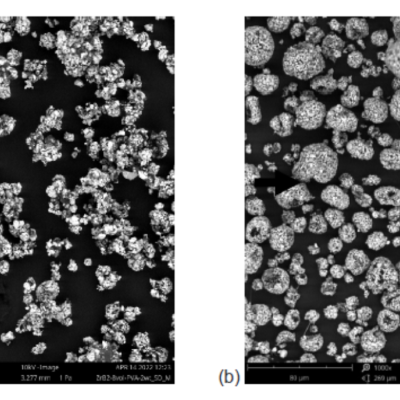
LLNL researchers refined custom mixing techniques and formulations in order to avoid clumping and fiber agglomerations for a flowable tailored feedstock that produces a homogeneous, survivable thermal barrier coating. Formulation improvements coupled with unexpected nozzle coupling from Buchi spray dry components leads to the production of fiber containing spray dried feedstock that can…
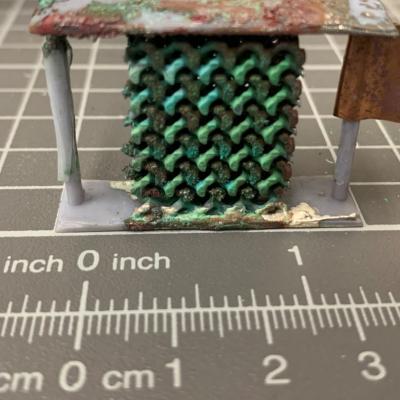
LLNL researchers have developed a fabrication process for creating 3D random interdigitated architectures of anodes and cathodes, eliminating the need for a membrane to separate them. This approach is similar to the repeating interdigitated multi-electrode architectures that also were developed at LLNL.

LLNL’s invention combines four approaches to enable on-the-fly multi-resolution metal droplet printing: (1) a nozzle with two or more orifices of varying diameter and length, (2) a set of corresponding pressure pulses that can eject droplets out of some, but not all, orifices in either magnetohydrodynamic (MHD-LMJ) or Pneumatic-LMJ, (3) the ability to change the pressure pulse on demand…

LLNL researchers’ approach to this challenge is to design a modular valve subsystem that redirects the flow away from the main nozzle to an “exhaust”. By re-routing the flow to a different exit port, steady state flow can be better maintained. The re-routing requires actuators that work in tandem; open and close of the nozzle and exhaust valves have to be executed simultaneously. …
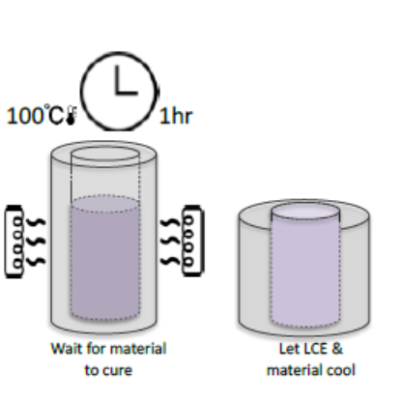
LLNL researchers developed novel workflows where material is first cast into the LCE molds at room temperature. Upon curing, the mold is induced to expand or contract (change shape) by external stimuli (light, heat, solvent) to self-release. A reduction to practice example used silica-loaded silicone ink casted into a LCE cylinder mold. It was cured at 100°C, and self-…
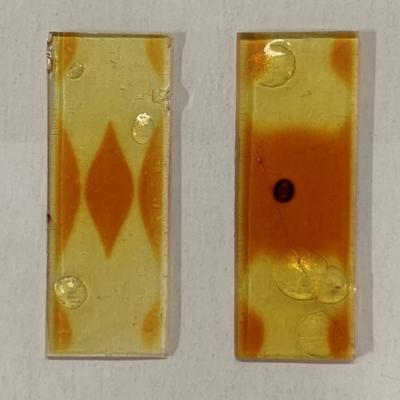
LLNL researchers have developed an innovative and uniform single-pot polymer multi-material system, based on a combination of 3 different reactive chemistries. By combining the three different constituent monomers, fine control of mechanical attributes, such as elastic modulus, can be achieved by adjusting the dosage of UV light throughout the additive manufacturing process. This…
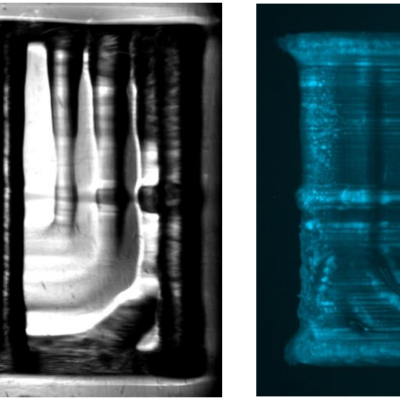
Three important aspects of this invention are: (1) the formulation of a photocurable resin containing a fluorophore that exhibits AIE behavior; (2) the method of in-situ and real-time characterization for monitoring the reaction kinetics during the photopolymerization and UV-curing process; and (3) the application of a new 3D steganographic ink for 3D encrypted structure.
Image Caption:…
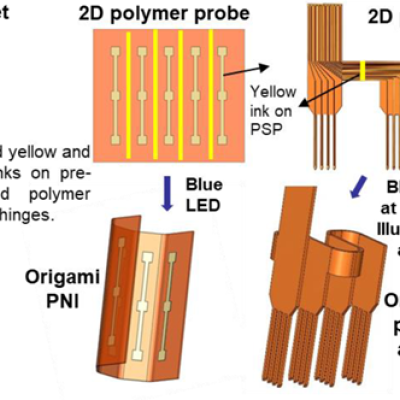
The approach involves 3D printing hinges made of Pre-Stressed Polymers (“PSP”) onto polyimide (“PI”) substrates. These hinges are then able to fold in response to externally applied stimuli, such as light. First, 2D PI devices will be microfabricated. Then, PSP infused with colored inks will be printed using Direct Ink Write (“DIW”) on the hinges of the PI devices. When…
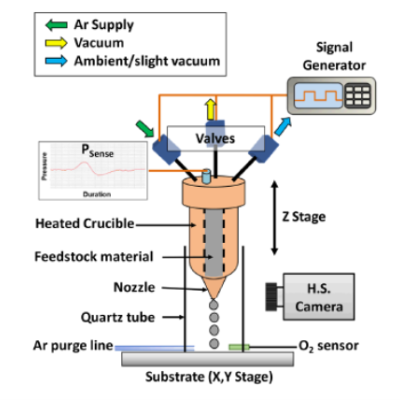
LLNL’s approach to meet this challenge is to use a pneumatic DOD-LMJ method wherein the nozzle is filled with a molten pure metal or metal alloy. There are two reservoirs in LLNL’s invention that are in direct contact with each other: the liquid metal reservoir that is constantly heated so the metal remains molten and an inert gas reservoir, which is connected to an inert gas pressure…
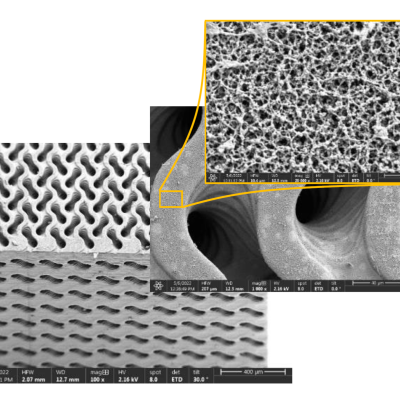
LLNL researchers have developed novel advanced manufactured biomimetic 3D-TPMS (triply periodic minimal surface) membrane architectures such as a 3D gyroid membrane. The membrane is printed using LLNL's nano-porous photoresist technology. LLNL’s 3D-TPMS membranes consist of two independent but interpenetrating macropore flow channel systems that are separated by a thin nano-porous wall…
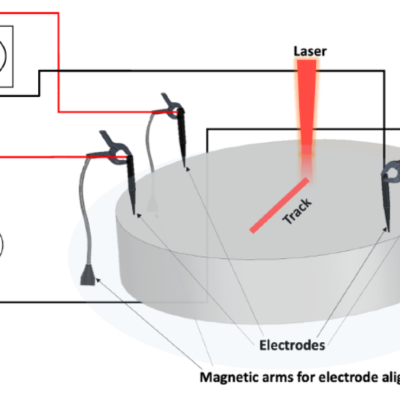
Electrodes that measure current and voltage are connected to the LPBF build plate by magnetic metal arms. These arms are placed on a steel weighted base that provides a high degree of mechanical flexibility to conform to small geometries and can be easily incorporated into a complex manufacturing system. Furthermore, the electrodes are connected to tapered copper tips that can…

LLNL has co-developed a number of technologies thatuse cold spray deposition that enable new designs for functional materials with low waste.

The novel approach is to make Ultem® into an ink for DIW or droplet printing by dissolving Ultem® in solvents, such as tetrahydrofuran. This produces a viscous solvent-melt that is loaded into an ambient temperature extrusion system and deposited into a defined structure by the 3D printer. Solvent mobility is limited by the polymer structure, and further solvent removal allows…
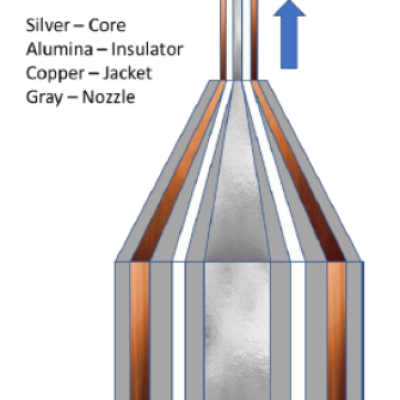
LLNL’s novel approach is to use Direct Ink Write (DIW) with a co-extrusion nozzle to enable the extrusion of multiple materials as one coil. With this method, LLNL researchers were able to produce an insulating wire that is composed of three different materials, axial conducting and insulating from its inner core to its outer sheath. After heat treatment, the printed wireI was then…

Beam Element-based Topology Optimization (“BETO”) is one of the conventional ways to design microstructures. It starts with an initial design that is composed of many beam elements. LLNL’s invention uses accurate Component-wise Reduced Order Models (“CWROM”) rather than the inaccurate beam elements. In doing so, the process becomes computationally efficient and fast, as each…
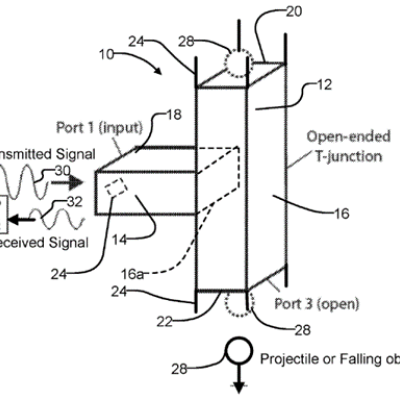
LLNL’s novel approach is to use waveguide-based devices and microwave energy to perform characterization of the projectile or droplet. Various embodiments of droplet devices can determine the size, motion (position, velocity, and acceleration), rate, and material elements of a moving element. This invention uses a tubular housing having a first end (input port) and a second end (…

LLNL’s approach to designing logic gates uses heuristic as well as with the Freedom and Constraint Topologies (FACT) methods; these gates are then produced using existing additive manufacturing processes. The 10,122,365 and 10,678,293 patents describe how to fabricate the gates; the

LLNL’s approach is to design and fabricate a massively-parallel microanode printhead using a custom complementary metal-oxide semiconductor integrated circuit (CMOS IC) chip with independent electronics for each pixel. This microanode in close proximity to the cathode surface will electroplate dissolved ions into a small voxel. The probe then moves and continues to deposit material…
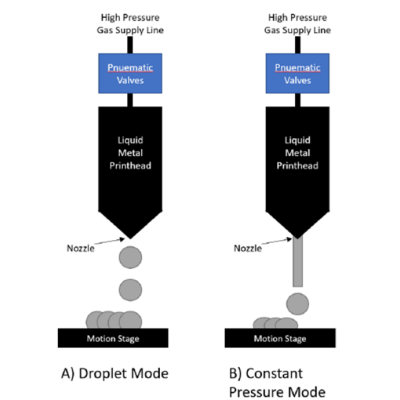
LLNL researchers have developed an approach is to use pneumatic droplet ejection devices to rapidly 3D print solid metal parts that also have a smoother surface finish than conventional liquid metal printing. Pneumatic droplet ejection printers can be used in two different modes: “droplet mode” uses pulsed gas pressure to create individual droplets of liquid metal that are collected to…

A set of images generated by multiple passes over the same area can be coherently integrated by this technology developed by LLNL researchers. The primary difficulty with coherently combining different passes is registering the images obtained from each pass, particularly if a pass only partially covers a given area.
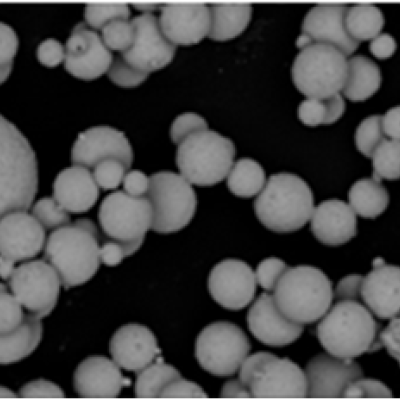
LLNL has developed a process to partially sinter starting material composed of smaller-sized powder particles to obtain a loose powder product that have larger-sized particles. To avoid the undesired formation of a single fully-sintered piece, the starting powder material is heated for a relatively shorter time. The time and temperature required for partial sintering is…

Improving the active material of the Zn anode is critical to improving the practicality of Zn-MnO2 battery technology. LLNL researchers have developed a new category of 3D structured Zn anode using a direct-ink writing (DIW) printing process to create innovative hierarchical architectures. The DIW ink, which is a gel-based mixture composed of zinc metal powder and organic binders, is…
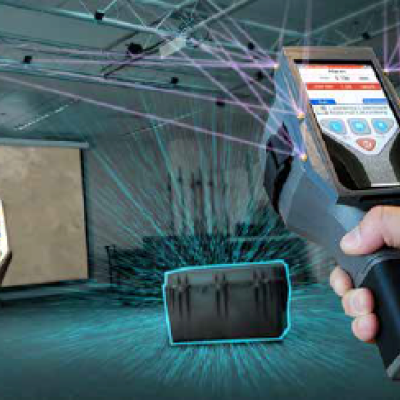
To address the need for realistic and high-fidelity first responder training, a multidisciplinary team at LLNL has worked to establish the new gold standard simulator called TARANTULA (Tactical Augmented Reality Applications for Nuclear Emergency Support Team (NEST) Training using Livermore Analytics). TARANTULA is a scientifically accurate, fully functional, field-deployable simulator that…
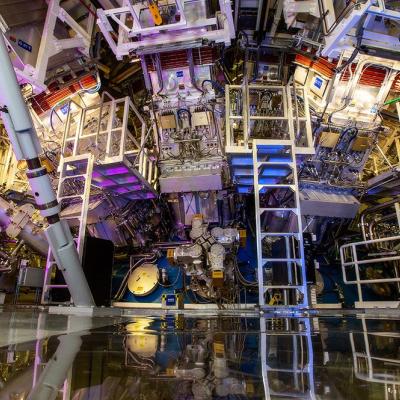
This novel detector for characterizing IFE implosions is an alternative to the current RTNADs to measure neutron fluxes > 3x1011 neutrons/cm2 at high shot rates. The detector consists of a stack of small square metal wafers separated by thin insulating spacers. Every other wafer is held at high voltage while the remaining wafers are grounded. The stack acts as an…
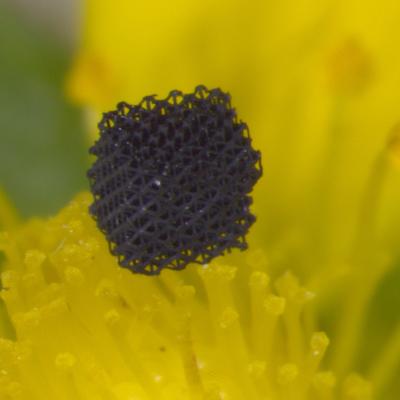
To overcome challenges that existing techniques for creating 3DGs face, LLNL researchers have developed a method that uses a light-based 3D printing process to rapidly create 3DG lattices of essentially any desired structure with graphene strut microstructure having pore sizes on the order of 10 nm. This flexible technique enables printing 3D micro-architected graphene objects with complex,…

The novel approach developed by LLNL researchers is to use an electric field as the non-contact-based powder remover. The main components of the remover are an electrode and a dielectric layer. As the remover moves across the stage, a high voltage is applied to the electrode that forms an electric field between the electrode and the powder bed. Under the influence of the…

LLNL’s novel approach utilizes a number of techniques to improve reconstruction accuracy:
- Better coding scheme-based techniques
- Hardware-assisted techniques
- Adaptive fringe projection techniques
- Multi-exposure based techniques
The method requires specific calibration procedures and control of the hardware, which is achieved through a digital twin…
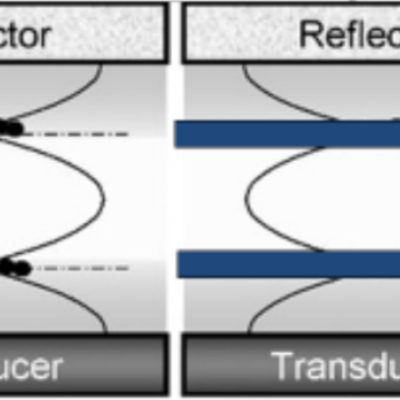
This novel AM approach utilizes cavitation bubbles generated within liquid resin by ultrasonic energy that trigger, induce, or catalyze a polymerization process (3D Ultrasound Polymerization). Ultrasound may be generated by piezoelectric transducers or high-power lasers and by modulating the ultrasound wave (frequency and amplitude), the cavitation site could be directed.

LLNL’s MVAM method comprises of a microwave applicator array coupled to a time-reversal beam steering algorithm to focus and deposit microwave energy in the feedstock material. The selective focusing of high-power microwave fields results in delivery of localized energy to arbitrary regions in a 3D volume. The localized area in the 3D volume heats up, allowing for the curing,…
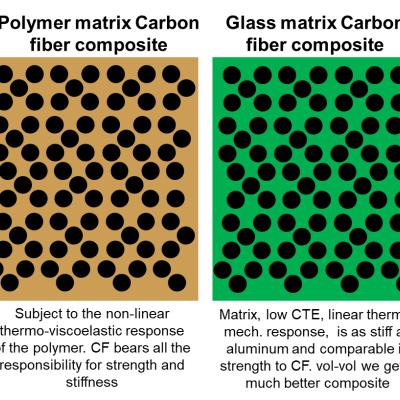
The approach is to combine the techniques of 3D printing aligned carbon fiber composites and melt-3D printing of glasses in a non-obvious manner to allow 3D printing (with controlled microstructure, fiber alignment, complex geometries, and advanced second order composite properties) of a new class of additively manufactured fiber-glass composites. It involves four major elements: …
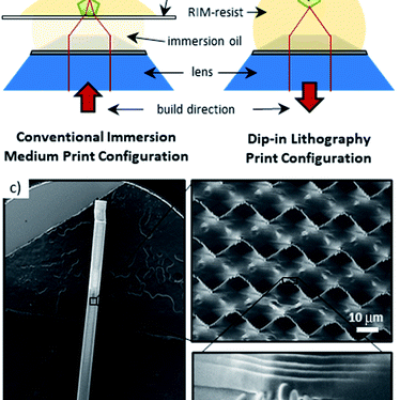
LLNL’s approach to producing refractive index matching (RIM) resin is to use a commercially available material known as polyhedral oligomeric silsesquioxane (POSS) precursors. To tune the refractive index, POSS can be functionalized with additives such as phenylthiol, until the refracted index match is achieved. For example, for a 1.4 NA oil objective lens, a RIM resin with a…
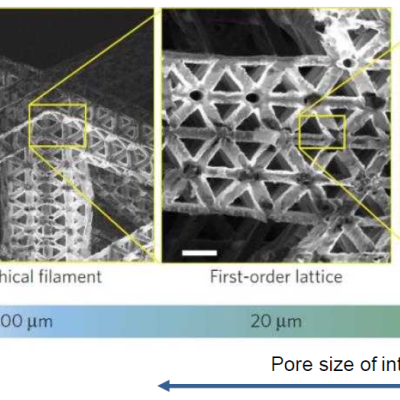
To get the best of both worlds – the sensitivity of LC-MS with the speed of PS-MS – and a functional substrate that can maintain sample integrity, LLNL researchers looked to 3D printing. They have patented a novel approach to create lattice spray substrates for direct ionization mass spectroscopy using 3D-printing processes.

LLNL researchers have discovered that some inexpensive and commercially available molecules used for other applications, could render certain lanthanide and actinide elements highly fluorescent. These molecules are not sold for applications involving the detection of REEs and actinides via fluorescence. They are instead used as additives in cosmetic products and/or in the pharmaceutical…
LLNL researchers, through careful control over the chemistry, network formation, and crosslink density of the ink formulations as well as introduction of selected additives, have been successful in preparing 3D printable silicone inks with tunable material properties. For DIW (direct in writing) applications, LLNL has a growing IP portfolio around 3D printable silicone feedstocks for…

LLNL’s SAS technology embedded within a facility is developed to sense, detect, localize, alert, and communicate an active shooter(s) to first responders. It relies on three integrated compact sensors that detect sound, infrared light (from the muzzle blast) and vibrations emanating from a gunshot. Fusing the data from these detectors minimizes false alarms.

The key to time-reversal for an active shooter detection/tracking application is being able to estimate the space-time transfer function (Green’s function) between source-enclosure-receiver. This approach begins with the acoustic mapping of an indoor muzzle blast.
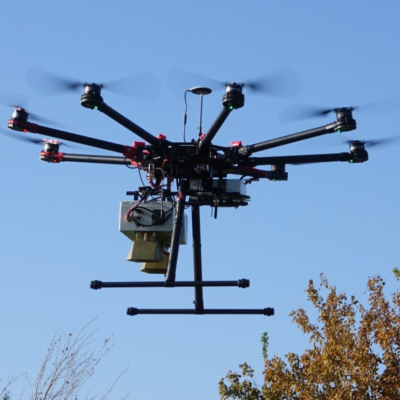
LLNL researchers have developed a lightweight drone-based GPR array that when flown over a surface with laid and/or buried objects could image the field of view and be able to detect targets and discriminate them from clutter. The imaging method employs a modified multi-static architecture to provide the highest signal to noise with the lowest system weight, making it ideal for airborne or…
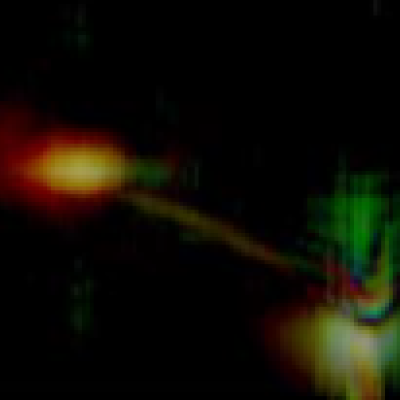
This technology uses three different frequency bands to create intensity maps of returned signals. Signals have traditionally been displayed as raw return data. The intensity of the return is represented by level of brightness. Assignment of a scalar value for intensity is used to determine the brightness of the image. In this technology, each frequency is given a designated…
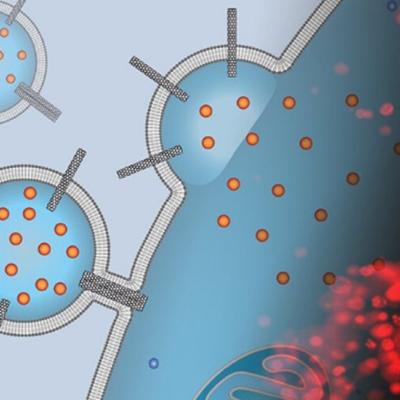
To address shortcomings of current liposome drug delivery systems, the patented innovation uses drug-loaded liposomes containing carbon nanotube porins (CNTPs) inserted into the liposomal membranes for the delivery of the encapsulated drugs. Short CNTPs (10 nm in length) with narrow diameter (0.8 nm) has been demonstrated to facilitate efficient fusion of lipid bilayers resulting in the…
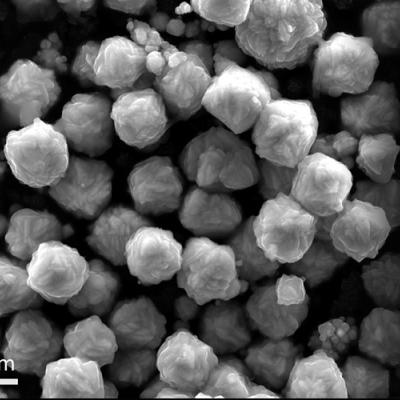
A new approach of developing synthetic antibacterial mineral assemblages can be used as an alternative treatment when traditional antibiotics fail in clinical and agricultural settings. Mineral mixtures can be synthesized with tunable metal release and reactive oxygen species generation that are capable of killing human pathogens and promoting wound healing. One of the key components in the…
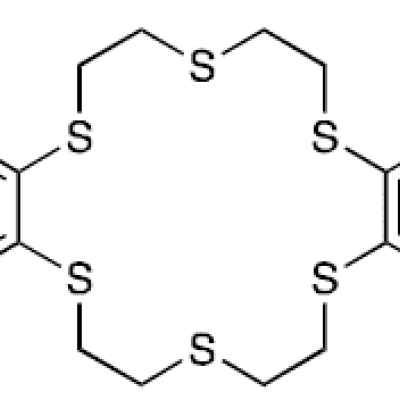
The method described in a pending patent application uses a novel thiacrown (dibenzohexathia-18-crown-6) for efficient extraction of 197m,gHg and 197gHg from irradiated Pt target foils. The separation of 197m,gHg and 197gHg from Pt foils using this novel thiacrown was found to be highly specific. No detectable amount of the Pt foil was seen in the…
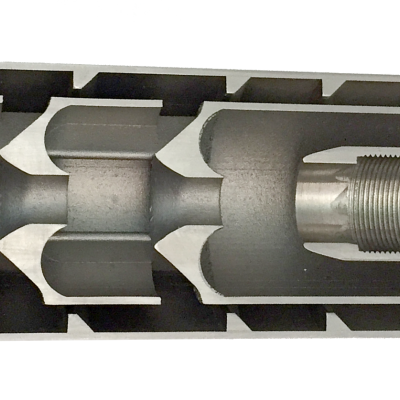
The suppressor has a series of chambers for the propellant to flow through, but unlike all traditional suppressors, the chambers are open, not closed. The propellant is not trapped. It keeps moving. We manage its unimpeded flow through the suppressor. This is the key underlying technology of our suppressor design that enables all the improvements over the 100-year old traditional designs.
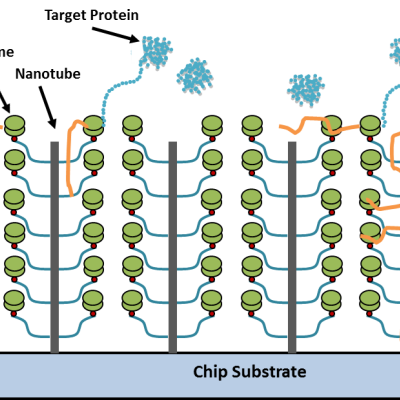
Combining the principles of nanotechnology, cell-free protein synthesis and microfluidics, LLNL researchers have developed a reusable, portable programmable system that can create purified, concentrated protein product in vitro in a microfluidic device containing nucleic acids.
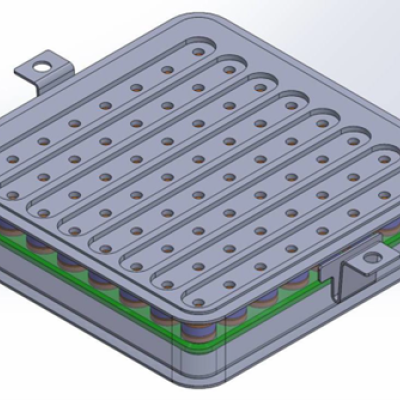
Many of the disadvantages of current interface devices can be overcome with LLNL’s novel interface design, which relies on area array distribution where independent interface connector subassemblies are positioned in a planar grid. Not only is the interface device expandable area-wise (without increasing contact force), but it could also be expanded height-wise, with multiple layers of…

To replicate the physiology and functionality of tissues and organs, LLNL has developed an in vitro device that contains 3D MEAs made from flexible polymeric probes with multiple electrodes along the body of each probe. At the end of each probe body is a specially designed hinge that allows the probe to transition from lying flat to a more upright position when actuated and then…
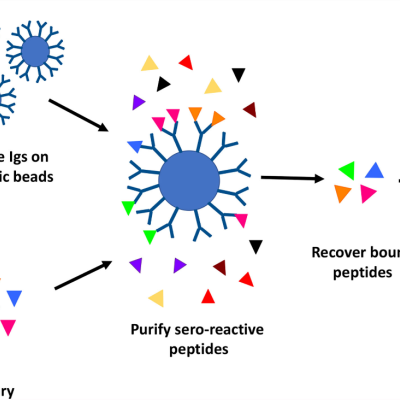
LLNL’s high throughput method involves proteome-wide screening for linear B-cell epitopes using native proteomes isolated from a pathogen of interest and convalescent sera from immunized animals.

LLNL’s method of 3D printing fiber-reinforced composites has two enabling features:
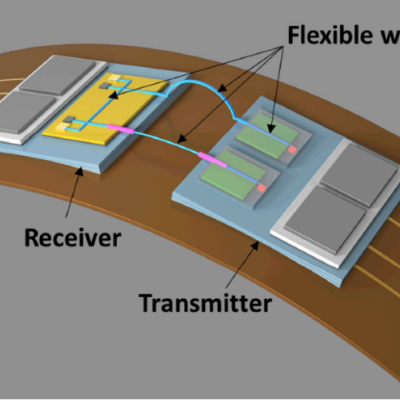
Commercial fiber optic cables are the current standard for carrying optical signals in industries like communications or medical devices. However, the fibers are made of glass, which do not have favorable characteristics for applications that require flexibility and re-routing, e.g. typically brittle, limited selection of materials, dimension constraints.
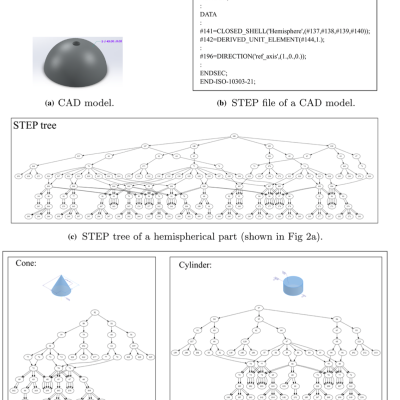
MBD captures the complete specification of a part in digital form and leverages (at least) the universal STEP file format. MBD has revolutionized manufacturing due to time and cost savings associated with containing all engineering data within a single digital source. LLNL researchers have been able to develop a novel encoding method to transform digital definitions in any given STEP file into…
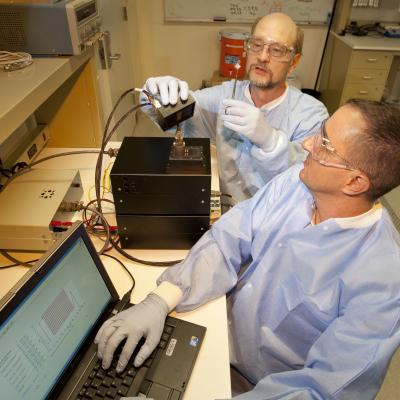
Solid-state distributed node-based rapid thermal cycler for extremely fast nucleic acid amplification (LLNL Internal Case # IL-12275, US Patent 8,720,209)
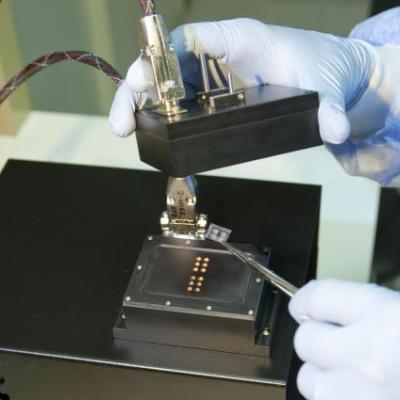
Laser heating of aqueous samples on a micro-optical-electro-mechanical system (LLNL Internal Case # IL-11719, US Patents 8,367,976;
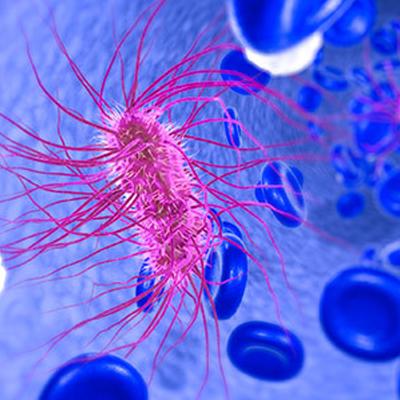
LLNL researchers have designed a synthetic, concatemeric bacterial expression vector that expresses a protein sequence that can be digested into a single peptide. The synthetic protein is designed to be secreted outside E. coli cells, and therefore can be purified using a His-tag from the cell supernatant (thereby reducing the need to lyse the cells for purification).
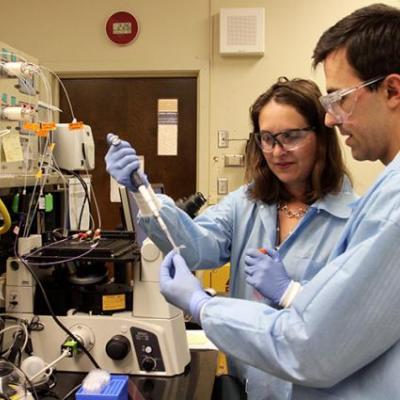
LLNL scientists have created a technology that utilizes electrical means, instead of optical methods, to (1) provide label-free detection of droplet morphology; (2) manipulate droplet position through trapping and actuation; (3) track individual droplets in a heterogeneous droplet population; and (4) generate droplets with target characteristics automatically without optical intercession. The…
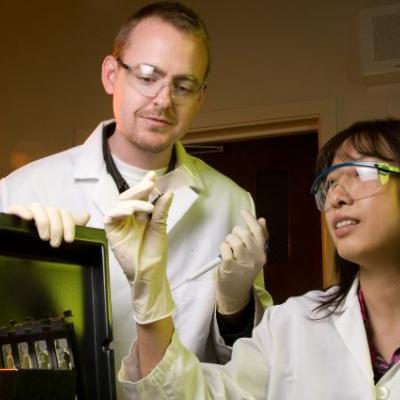
This device allows for observation of single cells encapsulated in droplets and provide the ability to recover droplets containing a cell of interest. This system provides the unique capability to monitor droplet contents from a few minutes to hours and overcome the limitations of the fluorescence activated cell sorting (FACS) in the purification of cell populations. The ability of this…
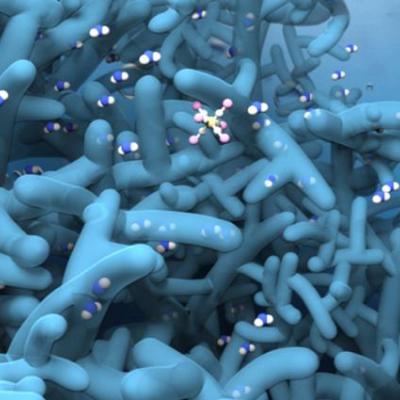
This invention consists of a functionalized membrane (e.g. polyethylene glycol (PEG)) and osmosis or electric potential as a driving force. The PEG membrane provides high biological particles separation and prevents sample for clogging due to the strong hydration of functional polymers layer and their resistance to protein adsorption.
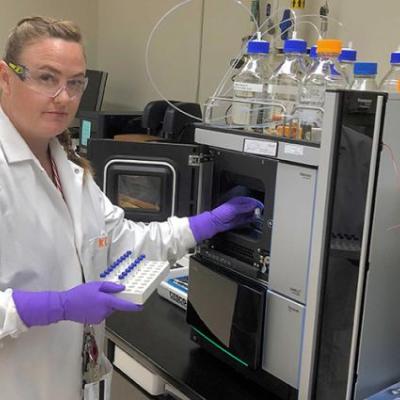
This invention is an improved chromatography device that utilizes the concept of a functionally graded material (FGM) for separation of components. The technology consists of a device that contains a FGM that is patterned to have a gradient in material properties (e.g. chemical affinity, surface chemistry, chirality, pore size, etc.) normal to the direction of flow of the mobile phase. The…
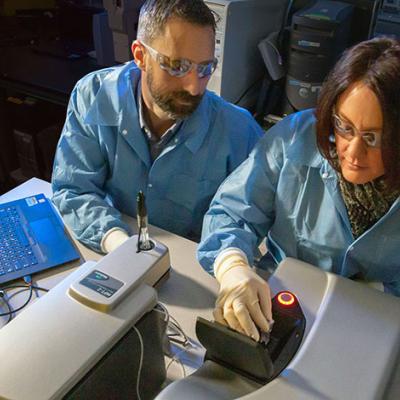
The art described here incorporates a planar integrated optical system that allows for multiple biochemical assays to be run at the same time or nearly the same time. Briefly, each assay can include one or more tags (e.g. dyes, other chemicals, reagents) whose optical characteristics change based on chemical characteristics of the biological sample being tested.

This technology describes a method for partitioning fluid into “packets” between polymeric sheets. The fluid to be partitioned is introduced between two polymeric layers or within a polymeric channel and the layers are sealed together to form an array or sequence of individual milliliter to picoliter samples as shown in figure below. This approach allows a continuous flow of samples through…

LLNL researchers have developed a variation of AMS technology that improves sample preparation, analysis, and cost for AMS. The device involves depositing liquid samples on an indented moving wire and passing the moving wire through a combustion oven to convert the carbon content of samples to carbon dioxide gas in a helium stream. The gas is then directed via a capillary to a high efficiency…
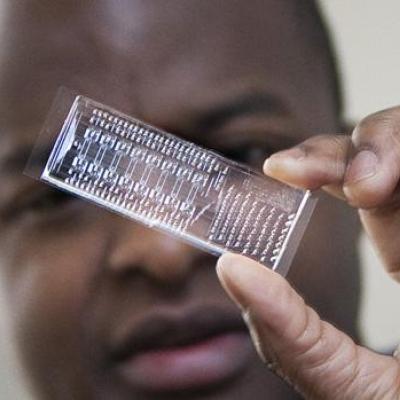
LLNL has invented a new high-throughput assay for sample separation that uses the vibrations of a piezoelectric transducer to produce acoustic radiation forces within microfluidic channels. The system includes a separation channel for conveying a sample fluid containing the different size particles, an acoustic transducer and a recovery fluid stream. The polymeric films containing the…

LLNL researchers have developed an apparatus capable of measuring and recording ultraviolet radiation that uses the Schottky diode/ZnSe/metal type UV sensor. This device can detect both UV-A (320-400nm) and UV-B(280-320nm) radiation. The present invention can also measure and accumulate doses with good sensitivity, and it can also store and make available the readings to be downloaded for…
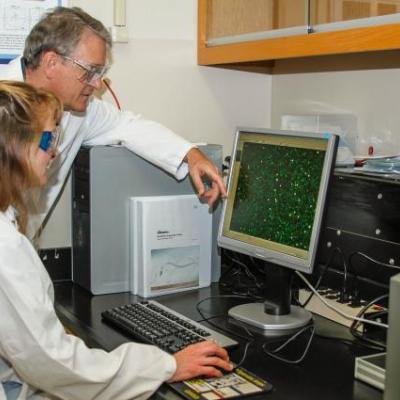
The invention developed by LLNL researchers proposes to use staged isotachophoresis to improve sample separation. One of the problems with isotachophoresis is that there is a tradeoff between the diameter of the separation column and the ability to isolate a species into a detectable band. For example, wider diameter channels run faster, but narrower channels provide better ability to isolate…
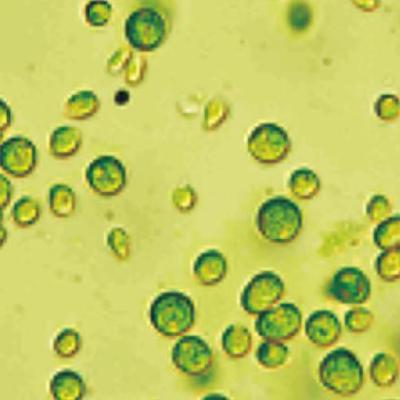
LLNL researchers have devolved a technique to separate or purify samples using electrophoretic separation. This invention corrects the problem associated with pH changes by using the electrode, which contacts the sample, itself a high-conductivity electrolyte made of liquid or gel materials. This will keep the metal surface electrochemistry physically remote from the sample, while…
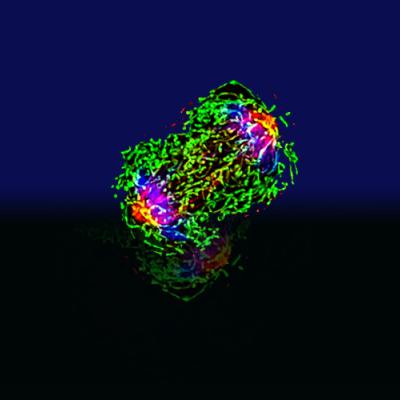
Researchers at LLNL have developed a more efficient and cost-effective method and system for synthesizing a critical D-aminoluciferin precursor and related compounds. D-aminoluciferin is as active as luciferin and provides a free -NH2 group for functionalization to attach peptide sequences corresponding to the cleavage site of a protease. This allows for the synthesis of bioluminescent probes…

LLNL's technology employs improved sorting strategies related to chip-based droplet sorting. This technology uses electromagnetic fields and non-contact methods to sort and identify monodispersed water-in-oil emulsion droplets in a microfluidic chip-based device. The system selects individual droplets from a continuous stream based on optical or non-optical detection methods as…

Researchers at LLNL have developed a method to passively sort individual microdroplet samples of uniform size based on stiffness and viscosity. Unlike electrical or optical methods for droplet sorting, this apparatus does not require a measurement step. Instead, particle separation occurs through changes in shearing forces determined by the stiffness of the particles in the microdroplet sample…

LLNL researchers have created a method that uses isotachophoresis for the exclusion and or purification of nucleic acids. Isotachopheresis (ITP) is an electrophoretic separation technique that leverages a heterogeneous buffer system of disparate electrophoretic mobilities. The researchers created a transverse ITP system that offers high-throughput sample preparation as the amount of sample…

The steady-state phenomenon generates thousands of microdroplets per second which is a problem when the stream of droplets needs to be slowed down or stopped. LLNL technology provides a method for generating and trapping microdroplets at a desired location and subsequently stopping the stream of microdroplets without droplet coalescence. These microdroplets can then be chemically reacted,…

The present invention uses magnetic fields to hold particles in place for faster DNA amplification and sequencing. This invention provides a method for faster DNA sequencing by amplification of the genetic material within microreactors, denaturing and de-emulsifying and then sequencing the material while retaining it in the PCR/sequencing zone by a magnetic field. Briefly, nucleic acid…
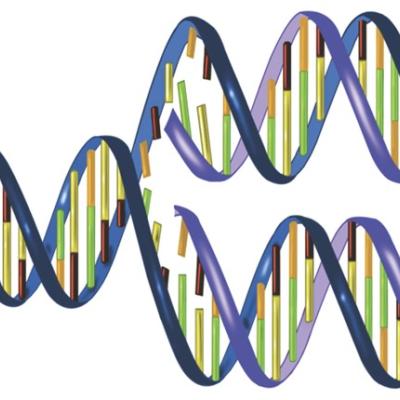
This invention is designed to sort and identify complex samples using parallel nucleic acid characterization. By isolating single or double stranded nucleic acids derived from complex samples, researchers can sequence previously unknown genetic material to identify novel viruses and organisms. The chip-based microfluidic system achieves this through microdroplet PCR amplification,…
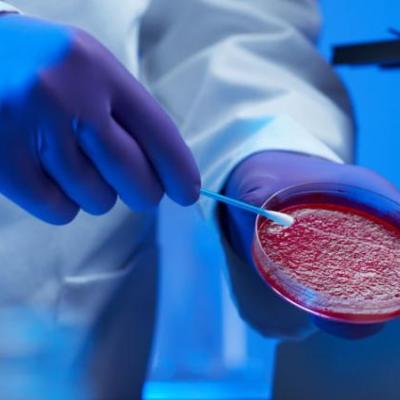
This technology is a photonic detection system developed by researchers at LLNL for the detection of biological or chemical threats with the intention of combining the collection, concentration and detection process onto a single platform. The present invention consists of a porous membrane containing flow-through photonic silicon crystals (see figure).

The described invention is a miniature fluidic device for separating particles suspended within a liquid sample that is introduced into the interior volume of the device. The device uses laminar flow and a combination of gravity and acoustic, electrophoretic, dielectrophoretic, and diffusion-based processes in concert to separate the different particle types and allow them to be collected…
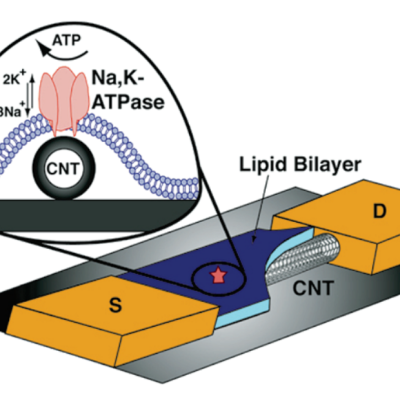
Researchers at LLNL have developed a nanotube sensor (single-walled or multi-walled carbon nanotubes) enclosed within a highly selective lipid bilayer that can detect variations in ion transport using signal amplification generated from the disruption of protein pores across the lipid layer. Changes in the device’s transistor current are recorded by an external circuit with high efficiency as…

Researchers at LLNL have created a new technology for performing pumping and valving operations in microfabricated fluidic systems. Traditional microfabricated devices have some disadvantages that defeat the advantages of miniaturization. For example, they require high power and voltage, and they need specific fluids to work properly and to be broadly applicable. The technology described here…
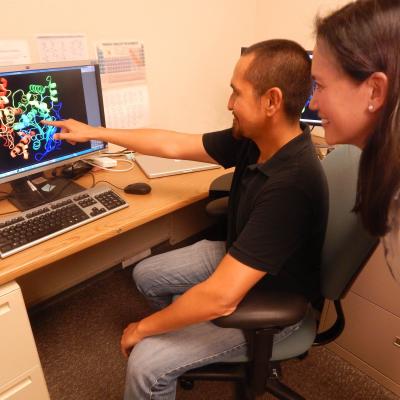
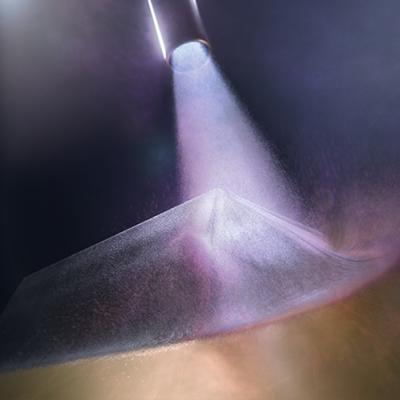

LLNL has a successful history of developing instruments for detecting and characterizing airborne pathogens. Often, aerosol characterizing instruments require highly focused particle beams with little or no transmission losses. In addition, they need to interface to the sampling environment with a very high sampling rate so that more aerosol particles can be collected and sensitivity can be…

LLNL scientists have designed a rapid PCR technology that incorporates the use of microfluidic thermal heat exchanger systems and is comprised of a porous internal medium, with two outlet channels, two tanks, and one or more exchanger wells for sample receiving. The wells and their corresponding inlet channels are coupled to two tanks that contain fluid with cold and hot temperatures. A…

LLNL has developed a new technology that provides a method for near-instantaneous heating of aqueous samples in microfluidic devices. The technology relates to a heating method that employs microwave energy absorption from a coincident low power Co-planar waveguide or microwave microstrip transmission line embedded in a microfluidic channel to instantaneously heat samples. The method heat…
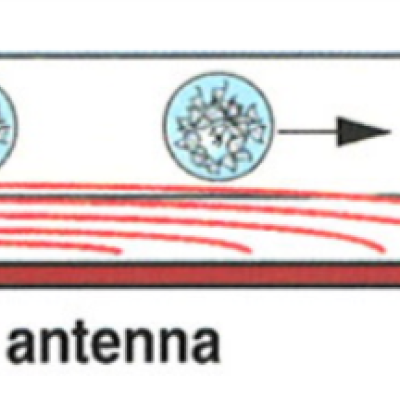
Researchers at LLNL have developed an instantaneous sample heating method to efficiently deposit thermal energy into a continuous stream or segmented microdroplets on a MOEMS device using an optimally low energy, commercially available CO2 laser. The device uses an ideal wavelength (absorption in the far infra-red (FIR) region (λ=10.6 μm)) to instantaneously heat fluidic partitions. The…

Researchers at LLNL have designed a new technology that allows the integration of a large bench-top thermal cycling instrument onto a miniaturized instrument. This instrument is powered and controlled by portable thumb-drive systems such as an USB. USB thumb-drives are commonly used to transfer data from the instrument onto a PC, however, in this new technology the thumb drive becomes the…
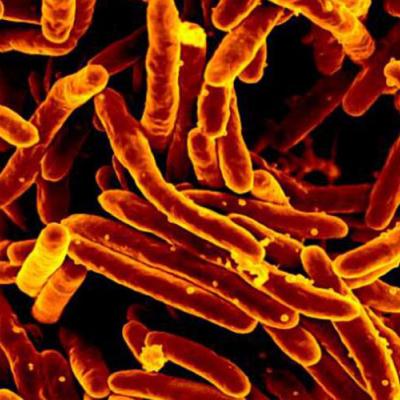
LLNL researchers have developed a high-volume, low-cost diagnostic test that is easy to use and provides results in under an hour. The testing platform will provide emergency responders and other medical professionals with the ability to screen individuals using oral and nasal samples, and obtain results in approximately 30 minutes. This point-of-care testing approach will enable rapid triage…

This technology describes a method for performing immediate in-line sample heating to promote the required chemical reactions for amplification, activation, or detection, depending on the thermodynamics of the particular assay involved. The basis of this technology is a method that employ microwave energy absorption to instantaneously heat fluidic partitions without heating the device itself…

LLNL researchers have developed a new method for faster, more accurate, and precise thermal control for DNA amplification. This technology uses sensor-controlled nodes to monitor and cycle materials through a microfluidic heat exchanging system. Thermal energy travels from a power module through thermal electric elements to sample wells. Sensors coupled to each sample well monitor and respond…

Livermore Lab researchers have developed a tunable shaped charge which comprises a cylindrical liner commonly a metal such as copper or molybdenum but almost any solid material can be used and a surround layer of explosive in which the detonation front is constrained to propagate at an angle with respect to the charge axis. The key to the concept is the ability to deposit a surrounding…
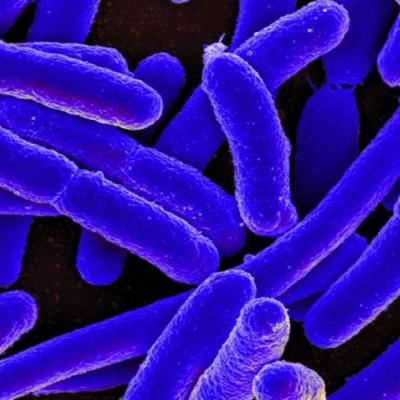
LLNL scientists developed novel hydrogels, which are biodegradable soft materials synthesized by a water-soluble polymer. Incorporating silver imparts antimicrobial activity to the material at low concentration compared to currently used silver nanoparticles. Our hydrogels are composed of silver ions instead of silver nanoparticles, which eliminates the toxicity concerns of modern silver…
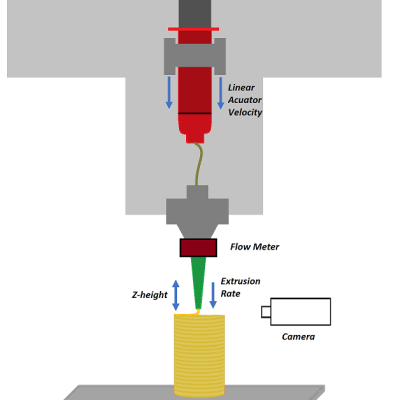
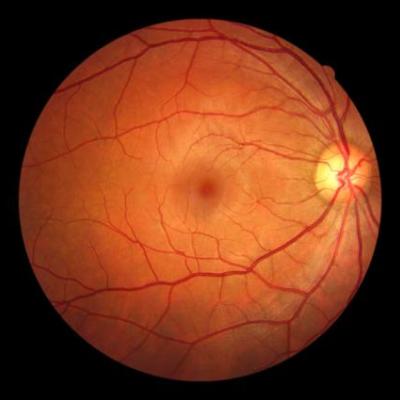
LLNL scientists have developed a method to ensure the accuracy of that tomographic image by applying adaptive optics (AO) to OCT in a single instrument (AO-OCT). AO stabilizes the image being captured by the OCT device by utilizing a Hartmann-Shack wavefront sensor and a deformable mirror, a type of mirror designed to compensate for detected waveform abnormalities (such as ones caused by a…
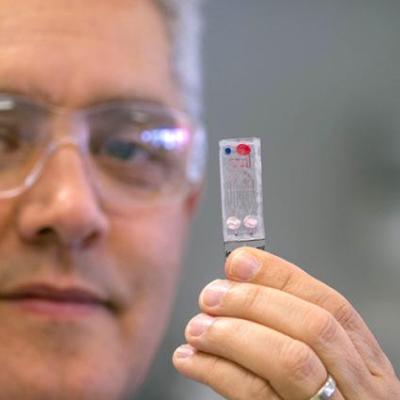
LLNL researchers have developed a portable device which analyzes one or multiple types of body fluids or gases to test for one or more medical conditions. A bodily fluid (such as blood, perspiration, saliva, breath, or urine) is put into a condenser surface and is then separated into both a primarily gas fluid component and a second one that is primarily liquid. These two samples from the same…

LNLL scientists have invented a method for multiplexed detection of PCR amplified products which can be completed in a single step. Highly validated species-specific primer sets are used to simultaneously amplify multiple diagnostic regions unique to each individual pathogen. Resolution of the mix of amplified products is achieved by PCR product hybridization to corresponding probe sequences,…

LLNL scientists have created a standalone pathogen identifier that can be placed in public settings, such as in stores or on street corners. Not unlike an ATM in physical size, this kiosk will accept biological samples from an individual for multiplexed analysis. The sample collection process will be sufficiently simple such that anyone could begin the diagnostic process after making the…

LLNL researchers have invented a system for identifying all known and unknown pathogenic or non-pathogenic organisms in a sample. This invention takes a complex sample and generates droplets from it. The droplets consist of sub-nanoliter volume reactors which contain the organism sized particles. A lysis device lyses the organisms and releases the nucleic acids. An amplifier then magnifies the…
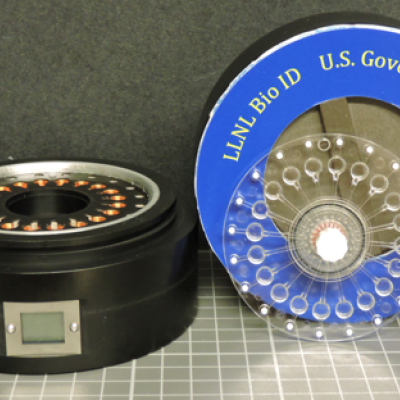
LLNL scientists have developed a battery-powered device which is low-cost and multi-chambered for the extraction and amplification of nucleic acids from environmental, clinical, and laboratory samples via loop-mediated isothermal amplification (LAMP). This platform identifies pathogenic bacteria and assists in determining the optimal treatment plan. A multi-chamber amplification cartridge in…

This LLNL-developed invention is multiplexed and utilizes the Luminex bead-based liquid array, which contains 100 different unique beads. Oligonucleotide probes with sequences complementary to the target sequences are covalently coupled to these unique beads. These capture beads are mixed with viral samples obtained from the patient via cheek swabbing or a throat wash and subjected to PCR in a…

LLNL researchers have developed a method to quickly and accurately identify the family of a virus infecting a vertebrate via PCR. Universal primer sets consisting of short nucleic acid strands of 7 to 30 base pairs in length were created to amplify target sequences of viral DNA or RNA. These primers can amplify certain identifying sequences of all viral genomes sequenced to date as well as…
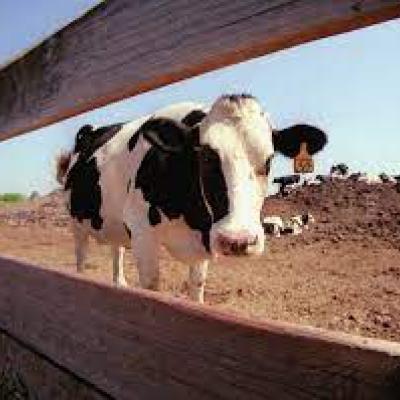
LLNL scientists have developed a high-confidence, real-time multiplexed reverse transcriptase PCR (RT-PCR) rule-out assay for foot and mouth disease virus (FMDV). It utilizes RT-PCR to amplify both DNA and RNA viruses in a single assay to detect FMDV as well as rule out other viruses that cause symptoms in livestock indistinguishable from those caused by FMDV, such as Bovine Herpes Virus-1 (…
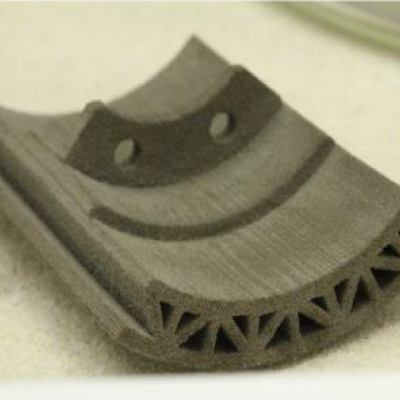
Livermore Lab researchers have developed a method that combines additive manufacturing (AM) with an infill step to render a final component which is energetic. In this case, AM is first used to print a part of the system, and this material can either be inert or energetic on its own. A second material is subsequently added to the structure via a second technique such as casting, melt…
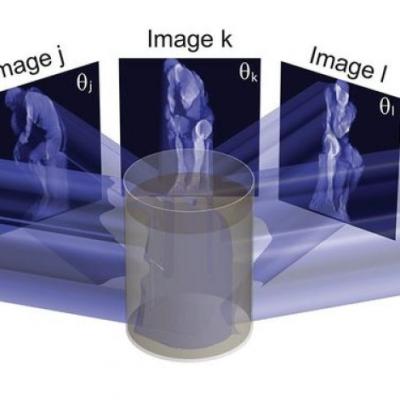
LLNL has developed a system and method that accomplishes volumetric fabrication by applying computed tomography (CT) techniques in reverse, fabricating structures by exposing a photopolymer resin volume from multiple angles, updating the light field at each angle. The necessary light fields are spatially and/or temporally multiplexed, such that their summed energy dose in a target resin volume…
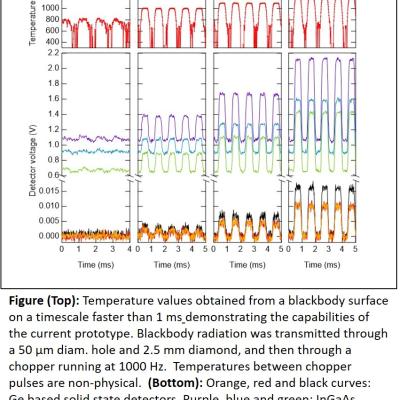
LLNL researchers have designed and tested performance characteristics for a multichannel pyrometer that works in the NIR from 1200 to 2000 nm. A single datapoint without averaging can be acquired in 14 microseconds (sampling rate of 70,000/s). In conjunction with a diamond anvil cell, the system still works down to about 830K.
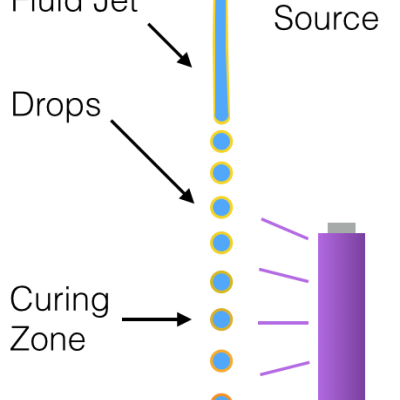

LLNL has developed an optically clear iodine-doped resist that increases the mean atomic number of the part. AM parts fabricated with this resist appear radio-opaque due to an increase in the X-ray attenuation by a factor of 10 to 20 times. Optical clarity is required so that the photons can penetrate the liquid to initiate polymerization and radio opacity is required to enable 3D computed…

LLNL has solved the challenges of depth-resolved parallel TPL by using a temporal focusing technique in addition to the spatial focusing technique used in serial writing systems. We temporally focus the beam (through optical set-up design) so that a sharp Z-plane can be resolved while projecting 2D “light sheets” that cause localized photo-polymerization. This enables printing of complex 3D…
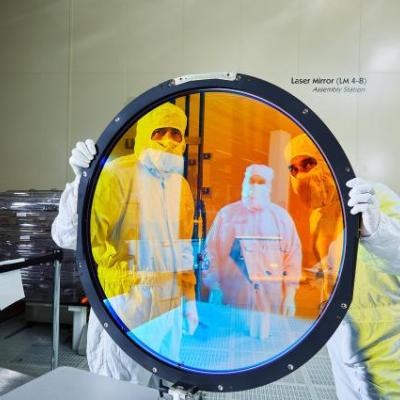
The LLNL method for optimizing as built optical designs uses insights from perturbed optical system theory and reformulates perturbation of optical performance in terms of double Zernikes, which can be calculated analytically rather than by tracing thousands of rays. A new theory of compensation is enabled by the use of double Zernikes which allows the performance degradation of a perturbed…
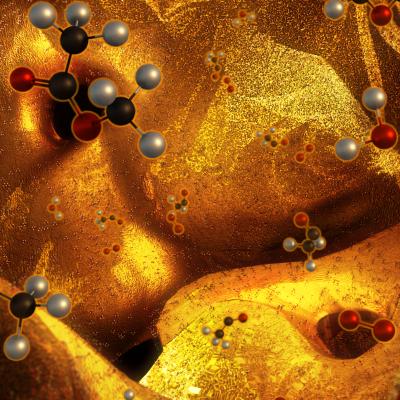
By combining 3D printing and dealloying., researchers at LLNL have developed a method for fabricating metal foams with engineered hierarchical architectures consisting of pores at least 3 distinct length scales. LLNL’s method uses direct ink writing (DIW), a 3D printing technique for additive manufacturing to fabricate hierarchical nanoporous metal foams with deterministically controlled 3D…
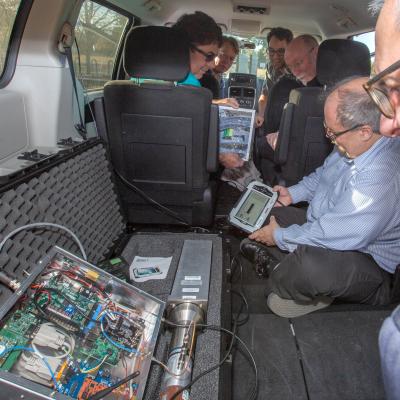
There are three main components to the RaFTS system: 1) the radiation detector, which can be of any type and from any manufacturer; 2) the RaFTS electronics, which produce the electronic pulses that are injected into the electronics of the radiation detector through a (to be) standardized port interface; and 3) the exercise scenario, which defines the synthetic radiation field and time-varying…

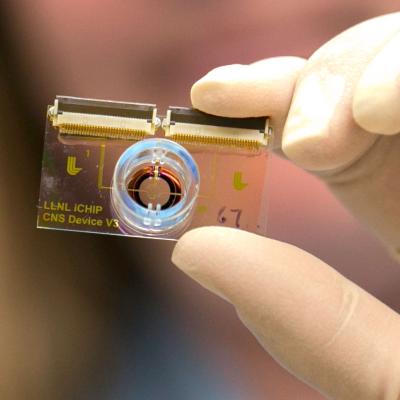
LLNL has developed a brain-on-a-chip system with a removable cell-seeding funnel to simultaneously localize neurons from various brain regions in an anatomically relevant manner and over specific electrode regions of a MEA. LLNL’s novel, removable cell seeding funnel uses a combination of 3D printing and microfabrication that allows neurons from select brain regions to easily be seeded into…
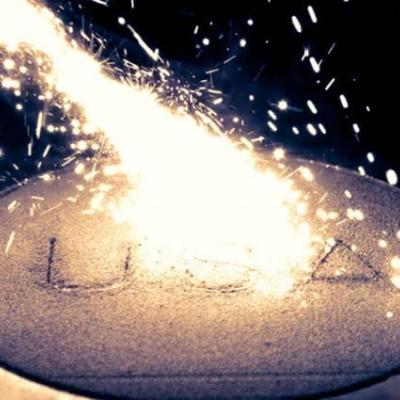
LLNL scientists have developed a new metal additive manufacturing technique that uses diode lasers in conjunction with a programmable mask to generate 2D patterns of energy at the powder surface. The method can produce entire layers in a single laser shot, rather than producing layers spot by spot as is currently done in powder bed fusion methods.
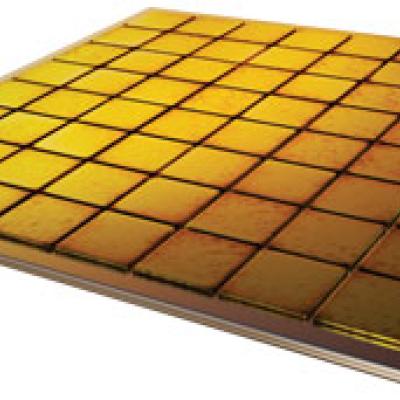
LLNL's neutron "Pillar Detector" fabrication technology uses semiconductor-based micro-structured elements as an electrical signal generation medium for the detection of neutrons. These materials in the form of semiconductor "pillars" embedded in matrix of high cross-section neutron converter materials (such as Boron) that emit charged particles upon interaction with neutrons. These charged…
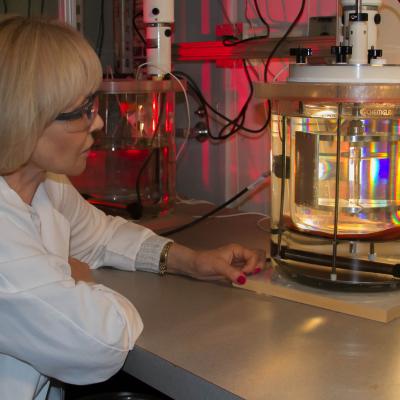
LLNL researchers have grown and characterized scintillator crystals of Strontium Iodide (SrI2). Scintillator energy resolution and light yield proportionality surpass NaI and are similar to LaBr3. The SrI2 scintillators doped with europium (Eu) exhibit very high light yields (> 100,000 photons/MeV), extremely good energy resolution (<3% at 662 keV) and excellent light yield…

The biotech industry aims to move towards an on-chip system for sample generation, amplification and detection of both DNA and RNA based organisms. LLNL has invented a new way of isolating samples in a system.
This invention enables creation of partitioned fluid "packets" between polymeric sheets for chemical separation, DNA amplification or PCR-based DNA detection. The polymeric…

LLNL's high fidelity hydrocode is capable of predicting blast loads and directly coupling those loads to structures to predict a mechanical response. By combining this code and our expertise in modeling blast-structure interaction and damage, along with our access to experimental data and testing facilities, we can contribute to the design of protective equipment that can better mitigate the…
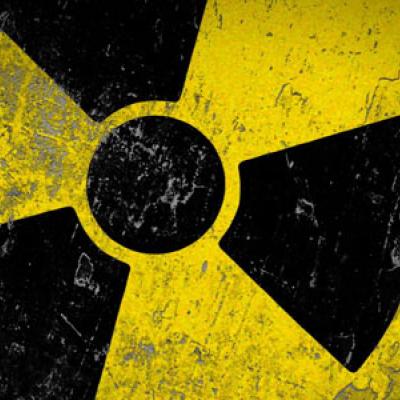
The LLNL detector measures radiation over a large dynamic range, spanning both high hazardous levels and weak levels, including natural background radiation. In weak radiation fields, the detector also measures gamma-ray spectra. The cost of the detector is significantly less than the total cost of existing separate detectors that could perform the same measurements.

LLNL's X-ray spectrometers based on STJ have been developed for high-resolution soft X-ray spectroscopy. STJ consist of two superconducting thin film electrodes separated by a thin insulating tunnel barrier. They measure X-ray energies from the increase in tunneling current after X-ray absorption in one of the electrodes excites additional charge carriers above the superconducting energy gap.…
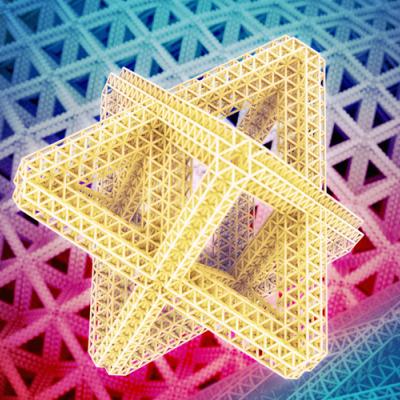
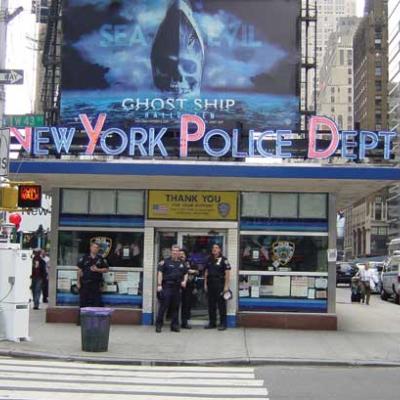
LLNL’s BioBriefcase is a compact and portable instrument capable of autonomously detecting the full spectrum of bioagents, including bacteria, viruses and toxins in the air. It uses the state of art technologies to collect, process, and analyze samples to detect, and identify genetic and protein signatures of bioagents.

LLNL has developed a wide band (WB) ground penetrating radar (GPR) technology to detect and image buried objects under a moving vehicle. Efficient and high performance processing algorithms reconstruct images of buried or hidden objects in two or three dimensions under a scanning array. The technology includes a mobile high-performance computing system allowing GPR array sensor data to be…

LLNL has developed a novel process of production, isolation, characterization, and functional re-constitution of membrane-associated proteins in a single step. In addition, LLNL has developed a colorimetric assay that indicates production, correct folding, and incorporation of bR into soluble nanolipoprotein particles (NLPs).
LLNL has developed an approach, for formation of NLP/…

LLNL has identified solution-grown organic crystals having scintillation efficiency not only close to, but even exceeding that of stilbene.. LLNL's invention relates to a new class of neutron detectors based on scintillation response of organic single crystals. More specifically, the use of organic molecules grown from solution and to molecules including the basic benzene or phenyl structure…

Using various excitation wavelengths, a hyperspectral microscope takes advantage of autofluorescence and polarized light scattering from cellular components to obtain composite images that highlight their presence. The light collection efficiency is maximized to achieve image acquisition times and rates suitable for in vivo applications.

This technology uses either of two X-ray wave-front sensor techniques, Hartmann sensing and two-dimensional shear interferometry, both of which are capable of measuring the entire two-dimensional electric field, both the amplitude and the phase, with a single measurement. Capturing both the absorption and phase coefficients of the index of refraction can help to reconstruct the image.…

LLNL has developed a radiation detector that cools to operating temperatures in 1-2 hours using two separate cooling stages. The first cooling brings the instrument to operating temperature. The embedded second cooling system achieves portable detection that can be sustained for 8-12 hours.
In addition, an integrated, hermetically-sealed package has been developed complete with…
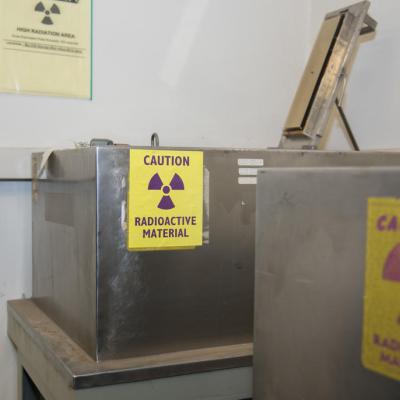
The invention utilizes the statistical nature of radiation transport as well as modern processing techniques to implement a physics-based, sequential statistical processor. By this we mean that instead of accumulating a pulse-height spectrum as is done in many other systems, each photon is processed individually upon arrival and then discarded. As each photon arrives, a decision is…

Scientists at Lawrence Livermore National Laboratory have developed a plastic that can detect neutrons, something previously thought impossible.
Livermore scientists demonstrated a plastic scintillator that can discriminate between neutrons and gamma rays with a polyvinyltoluene (PVT) polymer matrix loaded with a scintillating dye, 2,5-diphenyloxazole (PPO). They have found that…
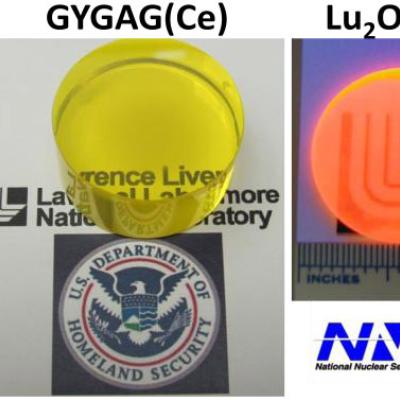
Transparent ceramic fabrication allows the production of gadolinium- , lutetium-, and terbium-based garnets which are difficult to grow by melt techniques due to phase instabilities. Phase stabilization of the garnets is accomplished by the addition of the intersubstitutional ions, Gallium and/or Scandium.
Scientists have developed many versatile and scaleable fabrication methods.…
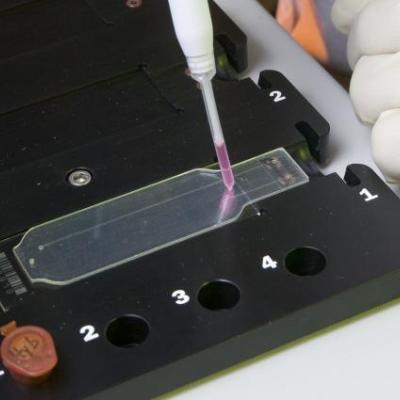
LLNL has developed a technology that provides near-instantaneous heating of aqueous samples in microfluidic devices. The method heats samples in a focused area within a microfluidic channel on miniaturized chips. The microwave heating device is composed of a waveguide or microstrip transmission line embedded in a microfluidic channel. Aqueous solution microwave heating allows extremely fast…
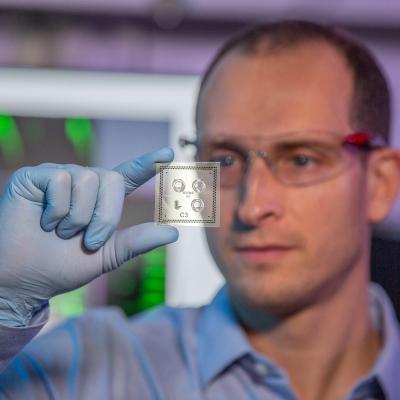
Lawrence Livermore National Laboratory scientists have developed a signal enhancing microchip apparatus and method that enhances a microfluidic detector's limits by magnetically focusing the target analytes in a zone of optical convergence. In summary, samples are associated with magnetic nanoparticles or magnetic polystyrene coated beads and moved down the flow channels until they are trapped…


